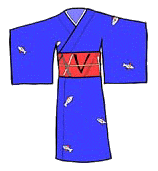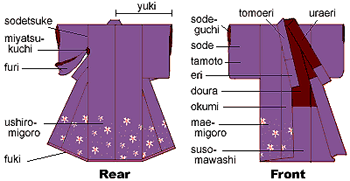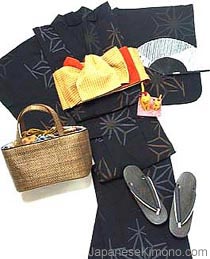|
Home
Kimono
Kimono History
Japanese Clothing
Kimono Fabric,
Kimono Pattern &
How to Make a Kimono
Kimono
Patterns & Kimono Styles
How to Wear a Kimono
Japanese Obi
& How to Tie an Obi Sash
Japanese
Yukata
- The Summer Kimono
Kimono
Robe & Japanese Robes
How to wear a Kimono Robe and Japanese Robes
Men's Kimono
Hakama
Pants
Japanese
Shoes & Japanese Sandal Types
Geta Sandals
Zori
Sandals & Tatami Sandals
Tabi Socks
Children's
Kimono
Wedding
Kimono
Happi
Coats & Japanese Festival Clothing
Favorite Links
& Sources
|
Kimono Fabric,
Kimono Pattern &
How to Make a Kimono
Kimono Fabric History
Textiles are perhaps the greatest treasure in Japan's
remarkable century old tradition of handicrafts. The Japanese techniques
of weaving and dyeing was originally borrowed from Korea and China. In
the eighth
century, tribute between Japan and her neighboring countries, Korea and
China was presented in bolts of silk and brocade. Over the centuries,
the Japanese treasured and studied those textile offerings and began
producing their own. The japanese have developed it to a level rarely
seen elsewhere. The unmatched skills and refined aesthetic have combined
to produce some of Japan's finest treasures.
was originally borrowed from Korea and China. In
the eighth
century, tribute between Japan and her neighboring countries, Korea and
China was presented in bolts of silk and brocade. Over the centuries,
the Japanese treasured and studied those textile offerings and began
producing their own. The japanese have developed it to a level rarely
seen elsewhere. The unmatched skills and refined aesthetic have combined
to produce some of Japan's finest treasures.
Since ancient times, textiles have been revered in Japan. According
to legend, when the angry sun goddess plunged the world into darkness by
hiding in a cave, other divinities enticed her out with a dance of blue
and white textile banners.
 How
to Make a Kimono How
to Make a Kimono
As the traditional textiles of Japan were made primarily for
personal attire, what we know today as the kimono determined not only
the construction of the weaves and the patterning of the fabric but also
the width of the cloth itself. A single bolt, or "tan", of
cloth measures approximately 9 meters in length and 30 centimeters in
width. This is sufficient to make one kimono, whether for men or for
women regardless of height and weight. Thus kimono fabrics as a rule are
sold by the bolt and rarely by the meter.
Kimono Pattern
The kimono pattern consists of four main strips of fabric. Two patterns
form the panels
covering the body and two panels for the sleeves. Additional smaller
strips form the narrow front
panel and collar.
Customarily, woven patterns and dyed repeat patterns are considered
informal. Formal kimono have free-style designs dyed over the whole
surface or along the hem. Originally, the kimono were worn in multiple
layers of different colors. Up to a dozen or more colorful layers of
contrasting colored kimono would be worn. Today, the kimono is normally
worn with a single layer on top of a slip style undergarment.
The
Kimono Pattern Parts

Sodetsuke - kimono armhole
Miyatsukuchi - opening under the sleeve
Furi - sleeve below the armhole
Ushiromigoro - back main section
Fuki - hem gaurd
Yuki - sleeve length
Sode-guchi - sleeve opening
Sode - sleeve
Tamoto - sleeve pouch
Eri - collar
Doura - upper lining
Okumi - front inside panel
Maemigoro - front main panel
Susomawashi - lower lining
Tomoeri - over collar
Uraeri - inner collar
 The
Changing of the Kimono Fabric The
Changing of the Kimono Fabric
The formal kimono and obi belts were traditionally made of
silk, silk brocade, silk crepes such as cherimen and satin weaves such
as rinzu. Due to production costs, limited availability of skilled
weavers and craftsman and the consumers economic and
"easy care" demand, the kimono industry is striving to capture
the demands by producing kimono of "easy care" casual type
fabric. Today, most formal kimono are made of rayon, cotton sateen,
cotton, polyester and other synthetic fibers except for the traditional wedding
kimono.
 NEXT
NEXT
|

 How
to Make a Kimono
How
to Make a Kimono
 The
Changing of the Kimono Fabric
The
Changing of the Kimono Fabric